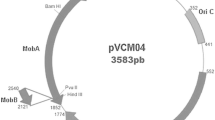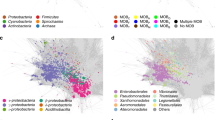Summary
Comparison of physical maps of the broad host range plasmids R751, R906 and R772, belonging to the IncPβ sub-group of the Escherichia coli incompatibility group P, reveals two large regions of similarity, separated by dissimilar regions which contain the majority of the cleavage sites for restriction endonucleases with hexanucleotide recognition sites. Mapping of the regions of these plasmids which show homology to probes specific for genetically characterised segments of the distantly related IncPα plasmid RK2, involved in plasmid maintenance or conjugal transfer, reveals that all four plasmids share a similar genetic organisation. In each case the homologous plasmid back-bone is interrupted by heterologous segments both between the essential replication loci oriV and trfA, and between the conjugal transfer regions tra1 and tra2, although in the case of R772 the segment of the backbone carrying the trfA and tra2 regions is inverted relative to that of the other plasmids. However, in the case of pJP4, shown to be a fourth member of the IncPβ sub-group, the back-bone is interrupted only by a single large segment adjacent to the trfA region. Mapping of the regions of the four IncPβ plasmids which show homology to Tn501 and nucleotide sequence determination at the ends of the homologous regions reveals that R906, R772 and pJP4 share a common mercury resistance region. This region, which appears to have been inactivated in R772, was probably inserted into a common ancestor of these plasmids by the transposition of an element related to an ancestor of Tn501. R751 shows no trace of the mercury resistance region, but contains a short relict of Tn501, derived from an independent insertion event.
Similar content being viewed by others
References
Birnboim HC, Doly J (1979) A rapid alkaline extraction procedure for screening recombinant plasmid DNA. Nucleic Acids Res 7:1513–1523
Bolivar R, Rodriguez RL, Green PJ, Betlach MC, Heynecker HC, Boyer HW, Crosa JH, Falkow S (1977) Construction and characterization of new cloning vehicles. II. A multipurpose cloning system. Gene 2:95–113
Brown NL, Ford SJ, Pridmore RD, Fritzinger DC (1983) Nucleotide sequence of a gene from the Pseudomonas transposon Tn501 encoding mercuric reductase. Biochemistry 22:4089–4095
Burkardt HJ, Riess G, Puhler A (1979) Relationship of group P1 plasmids revealed by heteroduplex experiments: RP1, RP4, R68 and RK2 are identical. J Gen Microbiol 114:341–348
Burkardt HJ, Puhler A, Wohlleben W (1980) Adenine + thymine content of different genes located on the broad host range plasmid RK2. J Gen Microbiol 177:135–140
Chikami GK, Guiney DG, Schmidhauser TJ, Heinski DR (1985) Comparison of ten IncP plasmids: homology in the regions involved in plasmid replication. J Bacteriol 162:656–660
Cross MA, Warne SR, Thomas CM (1986) Analysis of the vegetative replication origin of broad-host-range plasmid RK2 by transposon mutagenesis. Plasmid 15:132–146
Don RH, Pemberton JM (1981) Properties of six pesticide degradation plasmids isolated from Alcaligenes paradoxus and Alcaligenes eutrophus. J Bacteriol 145:681–686
Don RH, Pemberton JM (1985) Genetic and physical map of the 2,4-dichlorophenoxyacetic acid-degradative plasmid pJP4. J Bacteriol 161:466–468
Feinberg AP, Vogelstein B (1983, 1984) A technique for radiolabelling DNA restriction endonuclease fragments to high specific activity. Anal Biochem 132:6–13 with addendum 137:266–267
Figurski D, Meyer R, Helinski DR (1979) Suppression of ColE1 replication properties by the IncP-1 plasmid RK2 in hybrid plasmids constructed in vitro. J Mol Biol 133:295–318
Figurski DH, Pohlman RF, Bechhofer DH, Prince AS, Kelton CA (1982) The broad host range plasmid RK2 encodes multiple kil genes potentially lethal to Escherichia coli host cells. Proc Natl Acad Sci USA 79:1935–1939
Grinsted J, Bennett PM, Higginson S, Richmond MH (1978) Regional preference of insertion of Tn501 and Tn801 into RP1 and its derivatives. Mol Gen Genet 166:313–320
Grinsted J, Brown NL (1984) A Tn21 terminal sequence within Tn501: complementation of tnpA gene function and transposon evolution. Mol Gen Genet 197:497–502
Hille J, Van Kan J, Klasen I, Schilperoort R (1983) Site-directed mutagenesis in Escherichia coli of a stable R772::Ti cointegrate plasmid from Agrobacterium tumefaciens. J Bacteriol 154:693–701
Hirsch PR, Beringer JE (1984) A physical map of pPH1JI and pPH4JI. Plasmid 12:139–141
Holloway BW, Richmond MH (1973) R factors used for genetic studies in strains of Pseudomonas aeruginosa and their origin. Genet Res 21:103–105
Kahn M, Kolter R, Thomas C, Figurski D, Meyer R, Remaut E, Helinski DR (1979) Plasmid cloning vehicles derived from plasmids ColE1, F, R6K and RK2. Methods Enzymol 68:268–280
Kratz J, Schmidt F, Wiedemann B (1983) Characterization of Tn2411 and Tn2410, two transposons derived from R-plasmid R1767 and related to Tn2603 and Tn21. J Bacteriol 155:1333–1342
Lanka E, Furste JP, Yakobson E, Guiney DG (1985) Conserved regions at the DNA primase locus of the IncPα and IncPβ plasmids. Plasmid 14:217–223
Lanka E, Lurz R, Furste JP (1983) Molecular cloning and mapping of SphI restriction fragments of plasmid RP4. Plasmid 10:303–307
Maxam AM, Gibert W (1980) Sequencing end-labelled DNA with base-specific cleavage. Methods Enzymol 65:449–560
Meyer R, Figurski D, Helinski D (1977) Physical and genetic studies with restriction endonucleases on the broad host range plasmid RK2. Mol Gen Genet 152:129–135
Meyer R, Helinski DR (1977) Undirectional replication of the P-group plasmid RK2. Biochim Biophys Acta 478:109–113
Meyer RJ, Shapiro JA (1980) Genetic organization of the broad host range IncP-1 plasmid R751. J Bacteriol 143:1362–1373
Misra TK, Brown NL, Fritzinger DC, Pridmore RD, Barnes WM, Haberstroh L, Silver S (1984) Mercuric ion-resistance operons of plasmid R100 and transposon Tn501: the beginning of the operon including the regulatory region and the first two structural genes. Proc Natl Acad Sci USA 81:5975–5979
Norrander J, Kempe T, Messing J (1983) Construction of improved M13 vectors using oligodeoxynucleotide-directed mutagenesis. Gene 26:101–106
Reed KC, Mann DA (1985) Rapid transfer of DNA from agarose gels to nylon membranes. Nucleic Acids Res 13:7207–7221
Schmidhauser TJ, Helinski DR (1985) Regions of broad host range plasmid RK2 involved in replication and stable maintenance in nine species of Gram-negative bacteria. J Bacteriol 164:446–455
Shingler V, Thomas CM (1984) Analysis of the trfA region of broad host range plasmid RK2 by transposon mutagenesis and identification of polypeptide products. J Mol Biol 175:229–250
Shoemaker NB, Getty C, Gardner JF, Salyers AA (1986) Th4351 transposes in Bacteroides spp. and mediates the integration of plasmid R751 into the Bacteroides chromosome. J Bacteriol 165:929–936
Smith CA, Thomas CM (1983) Deletion mapping of kil and kor functions in the trfA and trfB regions of broad host range plasmid RK2. Mol Gen Genet 190:245–254
Smith CA, Thomas CM (1985) Comparison of the nucleotide sequences of the vegetative replication origins of broad host range IncP plasmids R751 and RK2 reveals conserved features of probable functional importance. Nucleic Acids Res 13:557–572
Stoker NG, Fairweather NF, Spratt BG (1982) Versatile low copy number vectors for cloning in Escherichia coli. Gene 18:335–341
Stokes HW, Moore RJ, Krishnapillai V (1981) Complementation analysis in Pseudomonas aeruginosa of the transfer genes of the wide host range R plasmid R18. Plasmid 8:202–212
Tanaka M, Yamamoto T, Sawai T (1983) Evolution of complex resistance transposons from an ancestral mercury transposon. J Bacteriol 153:1432–1438
Thomas CM (1981) Complementation analysis of replication and maintenance functions of broad host range plasmids RK2 and RP1. Plasmid 5:277–291
Thomas CM, Meyer R, Helinski DR (1980) Regions of broad host range plasmid RK2 which are essential for replication and maintenance. J Bacteriol 141:213–222
Villarroel R, Hedges RW, Maenhaut R, Leemans J, Engler G, Van Montagu M, Schell J (1983) Heteroduplex analysis of P-plasmid evolution: the role of insertion and deletion of transposable elements. Mol Gen Genet 189:390–399
Ward JM, Grinsted J (1982) Analysis of the IncP-1 group plasmids R906 and R751 and their relationship to RP1. Plasmid 8:244–252
Yakobson E, Guiney D (1983) Homology in the transfer origins of broad host range IncP plasmids: definition of two subgroups of P plasmids. Mol Gen Genet 192:436–438
Yamamoto T, Tanaka M, Baba R, Yamagishi S (1981) Physical and functional mapping of Tn2603, a transposon encoding ampicillin, streptomycin, sulphonamide and mercury resistance. Mol Gen Genet 181:464–469
Author information
Authors and Affiliations
Additional information
Communicated by J. Schell
Rights and permissions
About this article
Cite this article
Smith, C.A., Thomas, C.M. Comparison of the organisation of the genomes of phenotypically diverse plasmids of incompatibility group P: members of the IncPβ sub-group are closely related. Mol Gen Genet 206, 419–427 (1987). https://doi.org/10.1007/BF00428881
Received:
Issue Date:
DOI: https://doi.org/10.1007/BF00428881




